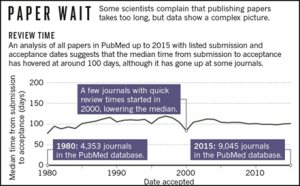What’s Trending?
Evidence-based medicine has been hijacked: a report to David Sackett. March 2016. John Ioannidis.
“EBM still remains an unmet goal, worthy to be attained.”
Handful of Biologists Went Rogue and Published Directly to the Internet. March 15, 2016. Amy Harmon.
NYT piece reviews biologists who posted their manuscript preprints to bioRxiv, a preprint server for biology, before submitting the manuscripts for peer review.
Does it take too long to publish research? February 10, 2016. Kendall Powell.
“Scientists are becoming increasingly frustrated by the time it takes to publish a paper. Something has to change, they say.”

Source: http://www.nature.com/news/does-it-take-too-long-to-publish-research-1.19320
The Cover Letter for a Manuscript
Cover letters for manuscript submissions serve to introduce your manuscript to the editors and reviewers and are a critical element of the publication process. Many journals offer instructions and/or templates for authors to follow when writing a cover letter.
Readings
“It is not simply an archaic form of communication that is becoming obsolete in a digital world; rather, it should be viewed as an opportunity to convey many important pieces of information about a paper to the editors.”
The cover letter provides the chance for authors to persuade the editors of the significance of their work in a less formal manner than what is written in the manuscript itself.
ACS Publishing Your Research 101 – Ep.2: Writing Your Cover Letter (Video)
50 Ways to Write a (Cover) Letter
“Always submit a cover letter (unless the journal doesn’t allow it) – I obviously can’t speak for editors at other journals, but I always read the cover letter. It’s often the first thing an editor reads, so don’t miss out on a chance to make a good impression.”
“Your cover letter is designed to influence the decision of the editor to send your manuscript out for peer review. The letter will argue that your manuscript is a good fit for the journal you are submitting it to and highlight your most important findings.”
4 Ways to Win an Editor’s Heart
“The cover letter allows the author to speak directly to the editor and to make the case as to why this manuscript should be published. A cover letter that provides the title and word count is not provocative and I interpret this as either a lack of understanding or as a halfhearted attitude about the journal. A strong cover letter can easily make the difference . . . between an immediate rejection and further consideration for publication.”
Does the Cover Letter Really Matter?
“As stated in the instructions of many journals, the goal of the covering letter is to emphasize the novelty and to communicate the potential implications of the reported findings.”
Writing Cover Letters for Scientific Manuscripts
Strong cover letters not only introduce your manuscript – they offer an important opportunity to convince journal editors to consider your manuscript for publication.
Submitting Manuscripts to Biomedical Journals: Common Errors and Helpful Solutions
Common errors include:
- Not disclosing all conflicts of interest for all authors
- Not disclosing potential issues of concern (eg, if some of the information has been published previously in print or electronically, or if a portion of the material has been presented elsewhere)
- Not providing required items as stated in the instructions for authors
- Is addressed to the wrong journal and/or editor
